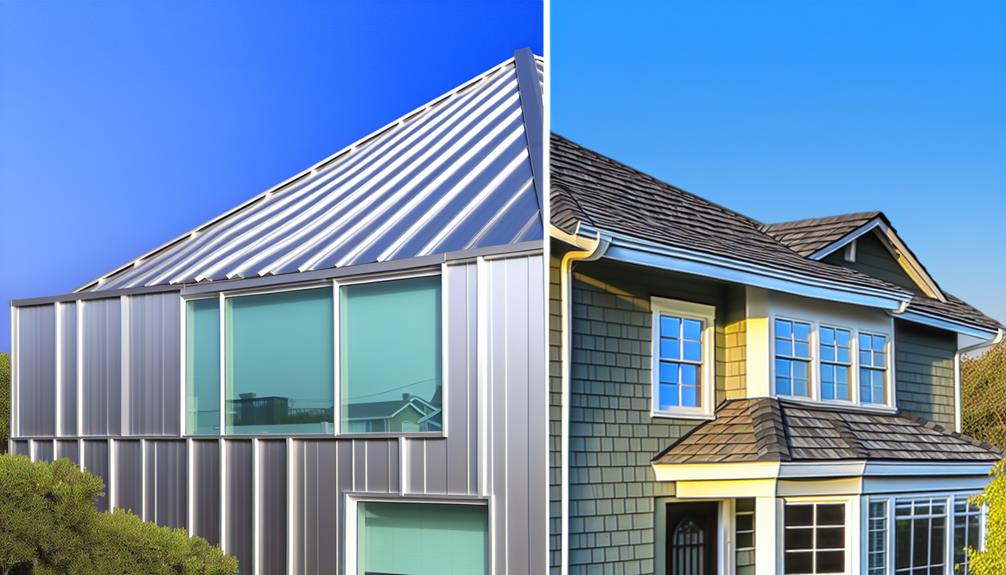When you’re choosing your new roof, you’re faced with a pivotal decision: metal or shingles. Each material brings its own set of advantages and challenges. Metal roofs are known for their durability and weather resistance but come with a higher initial cost. Shingles, meanwhile, offer a traditional appearance and generally cost less upfront. You might be weighing these options against factors like long-term savings, aesthetic preferences, and environmental impact. As you consider which roofing material aligns best with your needs, remember that the choice you make will impact your home’s protection, cost-efficiency, and style for decades. What will serve you best in the long run?
Durability Comparison
When comparing the durability of metal roof vs shingles, it’s crucial to note that metal typically offers a lifespan up to three times longer than that of traditional asphalt shingles. This substantial difference in material lifespan stems from metal’s superior weather resistance and inherent strength.
Metal roofing materials, including steel, aluminum, and copper, boast remarkable resilience against environmental elements. You’ll find that these roofs can withstand high winds, heavy rainfall, and even hail with minimal damage. Their ability to reflect solar radiant heat also reduces the potential for degradation from UV rays, a common pitfall for asphalt shingles.
On the other hand, asphalt shingles, while popular for their initial affordability and aesthetic options, often require more frequent replacement due to weathering and age. They’re particularly susceptible to damage from extreme temperatures, which can cause cracking and blistering. Additionally, in areas prone to high winds or frequent storms, asphalt shingles may struggle to maintain their integrity, leading to leaks and necessitating premature repairs or replacement.
Understanding these differences in material durability and weather resistance can guide you in making a more informed decision tailored to your specific climatic conditions and long-term roofing expectations.
Cost Analysis
While durability is a key factor, it’s also important to consider the cost implications of choosing between metal roofs and shingles for your property. Initially, metal roofing systems tend to have a higher upfront cost compared to traditional asphalt shingles. This cost, often twice or even thrice as much as shingles, reflects the metal’s durability and energy efficiency. However, when you factor in the lifespan and maintenance frequency, the long-term costs can be lower for metal roofs.
Metal roofs can last up to 50 years or more with minimal maintenance, whereas asphalt shingles may require replacement every 15 to 20 years, accompanied by frequent inspections and repairs. This difference in maintenance frequency can significantly affect your ongoing cost commitments.
Moreover, consider the impact on resale value. Properties with metal roofs often attract higher resale prices due to their longevity and modern appeal. This can offset the initial higher investment. In contrast, while shingles are less costly upfront, they don’t contribute as significantly to property resale values and require more frequent replacement, which can accumulate additional costs over time.
It’s crucial to weigh these financial factors alongside your budget constraints and long-term property plans to make an informed decision.
Aesthetic Differences
Beyond cost and durability, the aesthetic appeal of your roofing material plays a crucial role in the overall look and feel of your property. When you’re weighing metal roofs against shingles, you’ll find significant differences in both color variety and texture options, which can drastically influence your home’s curb appeal.
Metal roofing offers a sleek, modern look with an extensive range of finishes and colors. Manufacturers typically use high-performance paint systems that promise long-term color retention and rust resistance. You can choose from vibrant hues to more subdued tones, allowing you to match or contrast with your home’s exterior. Additionally, metal roofs can be fabricated with various patterns and profiles, from the traditional corrugated sheets to sophisticated standing seam designs.
On the other hand, shingles provide a classic appearance with a softer, more textured look. The color variety in shingles can be just as extensive, featuring shades that mimic natural wood, slate, or even stone. Asphalt shingles, the most common type, are available in numerous styles such as three-tab, architectural, and premium designer shingles, each offering unique textural qualities. This allows you to tailor the roof’s texture to complement or enhance your home’s architectural style.
Installation Process
Considering the installation process, you’ll find that metal roofs typically require specialized skills and tools for proper setup. Unlike shingle roofs, metal roofing demands precision in alignment and securing, which necessitates a thorough understanding of the material properties and installation techniques. The tool requirements are specific; you’ll need items such as seamers, snips, and metal cutting shears, which mightn’t be readily available in a standard roofing contractor’s kit.
Installation time for metal roofing can also be longer compared to shingles, especially if the roof design involves complex angles or multiple levels. Each panel must be carefully measured and cut to ensure tight seams and a secure fit. This precision extends the installation duration but contributes significantly to the roof’s overall performance and longevity.
On the other hand, shingle roofs are less complex to install. The materials are easier to handle, and the tools required are generally more common in the roofing industry. This simplicity significantly reduces the installation time and makes it a more feasible option for many homeowners. You’re also less likely to need a contractor with highly specialized skills, which can influence the overall cost and scheduling of your roofing project.
Environmental Impact
When selecting between metal roofs and shingle roofs, it’s crucial to consider their distinct environmental impacts. Metal roofing, predominantly composed of steel, aluminum, or copper, boasts high recyclability. At the end of its life, nearly 100% of a metal roof can be recycled, significantly reducing landfill waste. Furthermore, many metal roofing materials contain a portion of recycled content themselves, enhancing their sustainability profile.
On the other hand, asphalt shingles—the most common type of shingle roofing—present different challenges and opportunities in terms of environmental impact. While asphalt shingles are less expensive initially, they generally have a shorter lifespan compared to metal roofs and aren’t as easily recyclable. The recycling practices for asphalt shingles are improving, but currently, a significant amount still ends up in landfills. However, innovations in shingle recycling are on the rise, with facilities turning old shingles into new roads and roofing materials.
You’ll also need to consider local regulations that can influence your choice. Some areas might’ve strict guidelines on roofing materials based on environmental standards, which could sway your decision towards materials that are more sustainable and compliant with local codes. Ensuring you’re up-to-date with these regulations will aid in making a roofing choice that’s not only good for you but also good for the planet.




